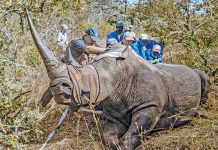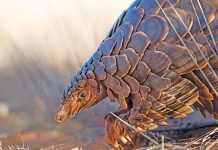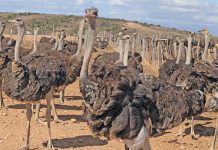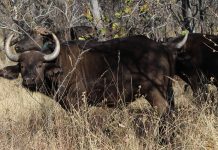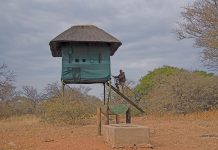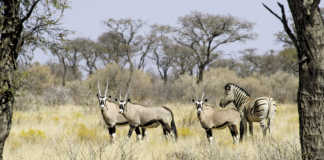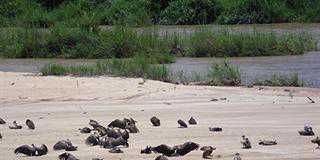Born in the Masai Mara game Reserve, Abel Erasmus spent the first eight years of his life in Kenya. “Needless to say, I was surrounded by game,” he recalls. “I have vivid memories of elephants rubbing themselves against our house and if our dogs happened to sleep outside they were snatched away by leopard.” Abel has poured this love of game into the new 14 000ha Otterskloof Private Game Reserve (OPGR) in the south-western Free State. Today, the OPGR carries 3 500 head of game from 22 different species. It’s an impressive initiative, that has its roots in Abel’s experiences while growing up in Kenya in the 1950s. The dream becomes realityBy 1961 the Erasmus family had relocated to South Africa. As Abel grew up he was drawn to the idea of hunting and having his own game farm. Establishing a bus company in the Free State in the 1980s was the financial platform to make that dream come true. In 1988, Abel bought a 2 000ha farm in Plooysburg near Kimberley. He slowly began introducing game and a partnership with neighbour, Fouché Naude, led to the creation of the Wintershoek Game Reserve. Rare game was already being bred here by the early 1990s.
“Fouché shared my passion for the outdoors and game,” says Abel.Both were keen to extend the reserve by 20 000ha to introduce the Big Five. But in 2005, a land claim on the SANPark’s Vaalbos National Park earmarked Wintershoek for expropriation to create the new Mokhala National Park. The reserve was eventually sold in mid-2006 and, forced to look elsewhere, Abel bought five stock farms bordering the Vanderkloof Dam near Philippolis that same year, which he would make into the OPGR.
This meant relocating some 1 000 animals to the new property. These included 70 disease-free buffalo, 40 sable antelope and 29 roan antelope – three of the animals he wanted to focus on breeding.
Abel wanted to transform the over-grazed former stock farms into a new conservation area. “It gives me a sense of achievement to see the land restored after over-grazing,” he says. “Since hunting with dogs was stopped at Otterskloof, the number of small game and birds has increased dramatically.”
Managing rare game
The bulk of turnover generated on OPGR is from trophy hunting of rare game, and buffalo (originating from Tanzania), sable and roan antelope (from Malawi) will only increase in value.A total of four buffalo, sable and roan antelope trophy bulls are hunted annually by international hunters. The buffalo go for US 500 (about R88 000), and the sable and roan antelope for US 000 (R56 000) each. The take-off of trophy animals will increase over time, says Abel.To improve the management of the 130 buffalo, 30 roan and 60 sable antelope currently on OPGR, all three breeding herds (augmented by a new bull to each herd every two years) are kept in a separate 2 000ha camp. It’s easily accessible by vehicle and has kloofs and thickets of bush as shelter. Weaned bulls between 12 and 18 months are kept in a separate 800ha camp until the age of five. Then they’re either transferred to the rest of the farm for trophy hunting or sold as breeding stock.
Philippolis lies on the fringes of the Great Karoo and is characterised by long, extremely cold winters that don’t allow for sufficient nutritious grazing, especially towards the end of the season. In addition, the natural vegetation, terrain and climate are alien for roan and sable antelope – a fact that cost Abel dearly during the relocation of his game when he lost some roan antelope. “We concluded that the animals were moved at the wrong time of the year, towards the end of winter, when the nutritional value of the veld was at its lowest,” he explains.Roan and sable antelope can also suffer from frostbite – something not uncommon where temperatures can drop to -10ºC. It’s a serious condition that can only be overcome by supplements of game pellets, lucerne and a production lick, given to buffalo as well.
“The sable and roan antelope get frostbite on the points of their ears, but I’ve had good success with the energy feeds,” says Abel.
Another major threat is the verlammingsbosluis (Karoo paralysis tick), says Abel. Parasites are dealt with by mixing Aloe Ferox bitters into feed and applying dip to the necks of animals via a height-adjustable feeding trough with specially designed rollers. “These feeding troughs, first invented by North West game farmer Gielie Booysen, and later improved and patented by Coen Smith from Vaalwater as “Oom Gielie se Dipbak”, have proved very effective, says Abel. “I’m not aware of any mortality due to the ticks so far this year,” he says.His gemsbok, which are very susceptible to these ticks, are doing extremely well, he adds. “The herd has increased from 70 to 220, which has surprised a lot of critics.”
Misdirected legislation and inbreeding
Abel believes game farmers play an important role in the conservation of game species, but admits their involvement can also compromise the genetic integrity of certain species. “Many small herds scattered across the country will prevent a catastrophe that can quickly wipe out an entire herd,” he explains. “But keeping small numbers in isolation may lead to inbreeding.“One of the biggest challenges for game breeders will be to convince authorities that they take genetic breeding seriously.”He understands the rationale behind some legislation such as the Threatened and Protected Species (TOPS) Regulations that came into force in February 2008 to protect species in their original habitat. “But it shouldn’t be enforced to the detriment of the viability of the game industry, which is important for conservation,“ he warns.
“The TOPS Regulations, for example, have affected game farmers’ ability to sell certain species due to a stringent regulatory permit system,” says Abel. “Take the current plight of red lechwe on OPGR,” he adds. “Due to TOPS it’s difficult to sell these antelope in South Africa, and OPGR are now looking at markets beyond our borders. Current firearm legislation is also problematic,” says Abel. “It’s already impacting negatively on our business negatively as new biltong hunters find it too arduous a task to secure firearm licences. “We’ll see the local hunting fraternity diminishing in the next 10 years,” he warns. “Biltong hunters are very important to the industry, as they’re the people consuming the meat, bearing in mind that only 8% of a herd of, say, impala are quality trophy animals.”
The way forward is clear for Abel. “Statistics show that the private game industry has played a major role in the survival of some species. “The industry needs to get more recognition for what it has achieved in a relatively short space of time,” he says.Contact Otterskloof Private Game Reserve on 051 773 7017/67 or visit www.otterskloof.co.za.

